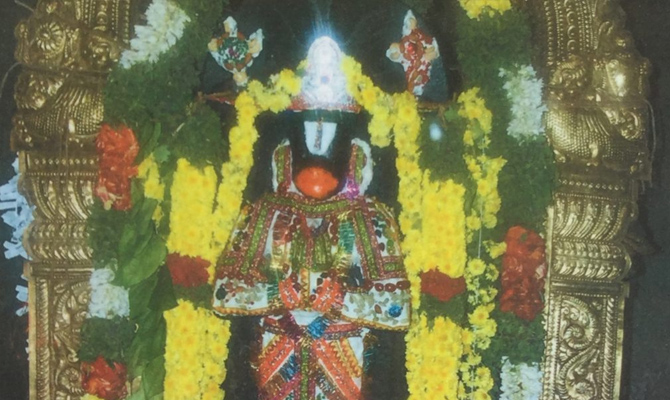
Lord Hanuman Bhakthi
Lord Hanuman Bhakthi Wherever Rama Naama is uttered with Bhakthi, Lord Hanuman will be present with tears in his eyes. That is the sincere bhakthi of Lord Hanuman towards Lord Rama. No wonder He is called “Siriya Thiruvadi” and just by uttering his naama, even the dangerous Rakshasas or demons do not have a chance to harm us.
Such a great deity is Lord Anjaneya who has chosen a place called Iyengarkulam near Kanchipuram to be his Sanctum Sanctorum where Sri Sanjeeviraayar Temple is located. When the war between Sri Rama and Ravana was so intensely fought at Srilanka, Ravana’s son Indrajit had launched the Naagasthra on Lakshmana and he was left unconscious. Though a lot of effort was put in, Lakshmana didn’t wake up. Sri Rama and others had to seek the help of a specialist who advised that a particular herb from the Sanjeevi Mountain is required to bring back Lakshmana to normal.
Everyone had unanimously agreed that Lord Hanuman is the only one who had the capability to bring the medicinal herb that was required. Sanjeevi, as the mount was called, was located in the Himalayas. As Sugreevan, Angadhan, Jaambavaan and others prayed to Lord Hanuman to bring the herb, Anjanai’s son had flown in search of the medicinal herb.
Once he had reached the mountain, due to lack of time, he wasn’t able to identify the medicinal herb that was prescribed. Hence, Lord Hanuman, who is the lord of boundless courage, valour and strength, uprooted the mountain and flew towards the spot. On His way, he had rested at a place called Iyengarkulam and then proceeded to His destination. At that moment, a small part of the mountain had fallen at this place, which resulted in the medicinal breeze that one enjoys at this holy place along with the grace of Lord Hanuman.
Having uprooted the Sanjeevi mountain, He is called Sanjeeviraayar and the Emperors of Vijayanagar had built Sri Sanjeevi Rayar temple during their reign and worshipped Him.
Iyankulam
Behind this temple, there is a huge pond which spreads across 130 acres of land. This looks like a big lake which adds to its scenic beauty. To get down in to the pond, there are steps which have been built in an artistic manner. Towards the northern bank of this pond, one can witness various sketches/pictures of Lord Perumal and statues which enact Ramayana giving us a visual treat. Since this pond has medicinal qualities of Mount Sanjeevi, bhakthas have experienced miraculous cure from their diseases while they take a holy dip in this pond.
Place devoid of Snake bites
This place is a testimony to the fact that Sri Anjaneyar had rested at this place with Mount Sanjeevi which has made this place a holy one. Iyengarkulam has never witnessed a victim of snake bite. Also, the water from this pond is hailed to have medicinal effects.
Chronological importance
This place is a demonstration of the flair with which Vijayanagar Emperors had mastered the art of architecture. Their commitment towards building these structures was of the highest order. This is displayed by four pillars made of a single stone each, which stand tall to showcase the antechamber. The steps that surround the vast lake and this temple were built during the reign of the Emperors of Vijayanagar. Archaeologists have confirmed that this place is referred to “Padaiveetu Rajya Kaliyur Kottathu Iyyan Kulathur” among the inscriptions that they could find.
There are 6 inscriptions that have been found for this temple. King Venkatan had deployed Nettoor Lakshmi Kumara Thathacharyar in 1597 AD to carve this pond called Dhadha Samudram and this temple was built at the banks of this pond. Likewise, Emperors Sri Krishna Devaraya and Venkatan-1 had been patrons of this temple and allocated lands to this shrine.
Special rituals were conducted on the 1st day of every tamil month and No Moon days during the times of Thamal Chenna Nayakkar. All this information was evident from the inscriptions seen at this place.
The temple is structured in such a way that Sri Sanjeevarayar is worshipping towards the direction of Ayodhya. Opposite to Him, Sri Rama, Sita Devi and Lakshmanan treat our eyes. Towards the frontage of this temple, there is a veranda, whose corners display huge rings made of stones. Out of these, just one or two are in good order now.
Close to these, the corridor outside, there is a gigantic stage made of stone. It is understood that this was used to give out food to the needy in those days.
Next to this stage, one can see Garudaazhvar facing North, in a posture of devotion, indicating that the sky is His umbrella.
Besides these features, this temple also has a 25 pillared Chamber, which displays exemplary skill in carving statues that represent Srimath Ramayana. To add to the beauty of these 25 pillars, statues depicting warriors on horses have been carved here.










